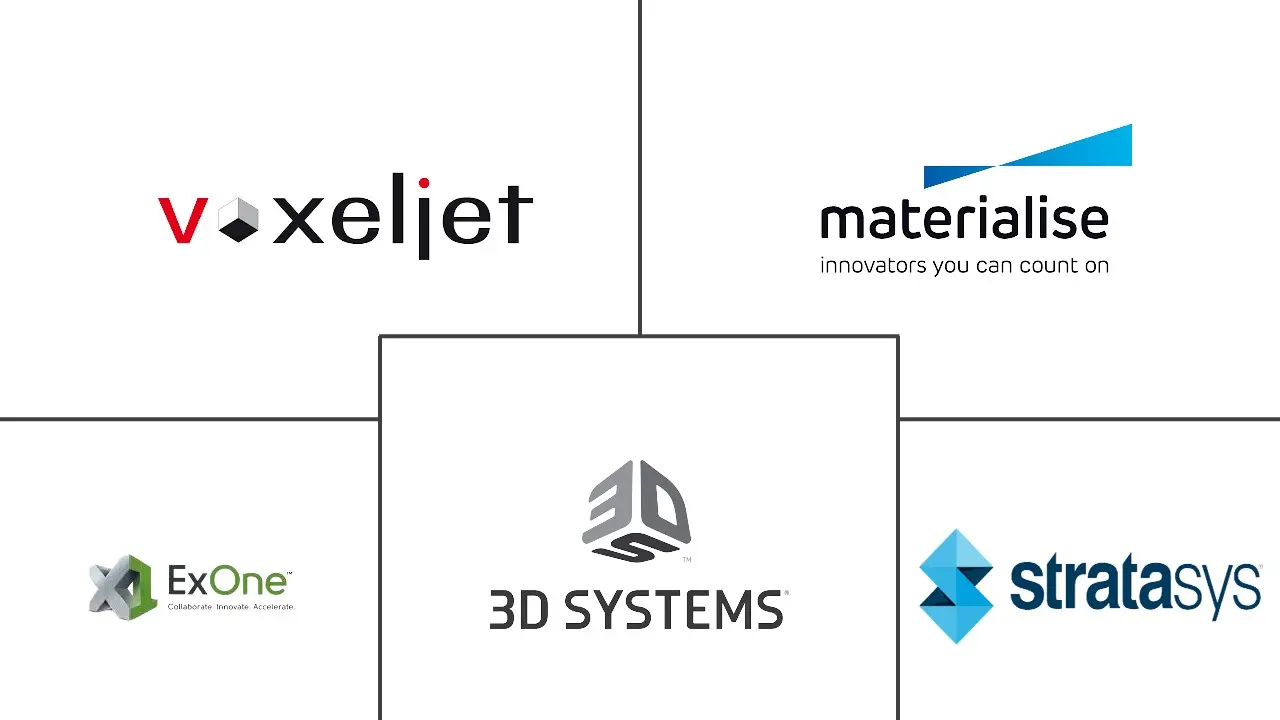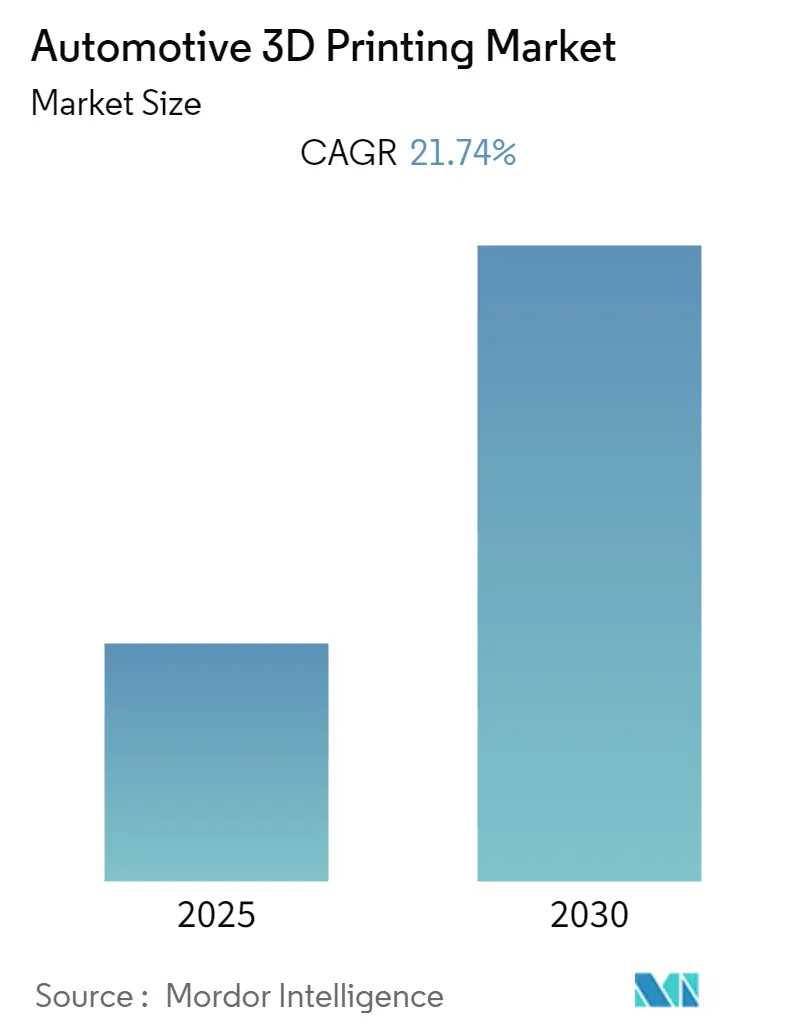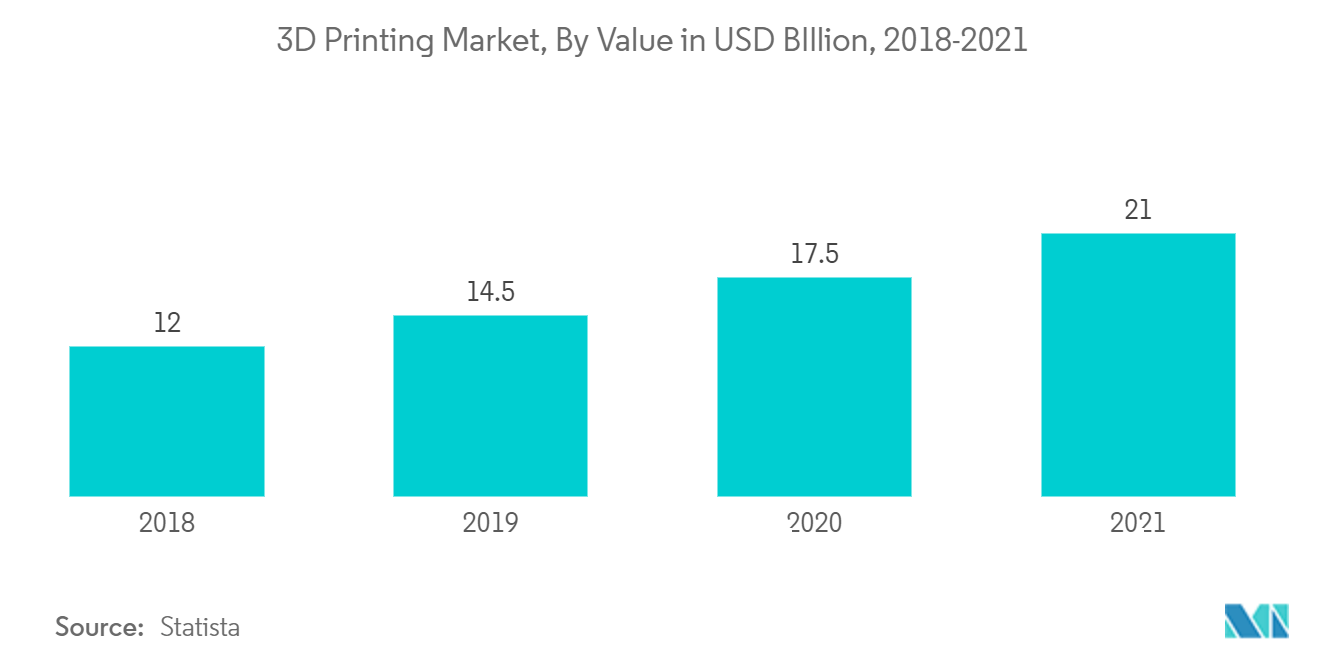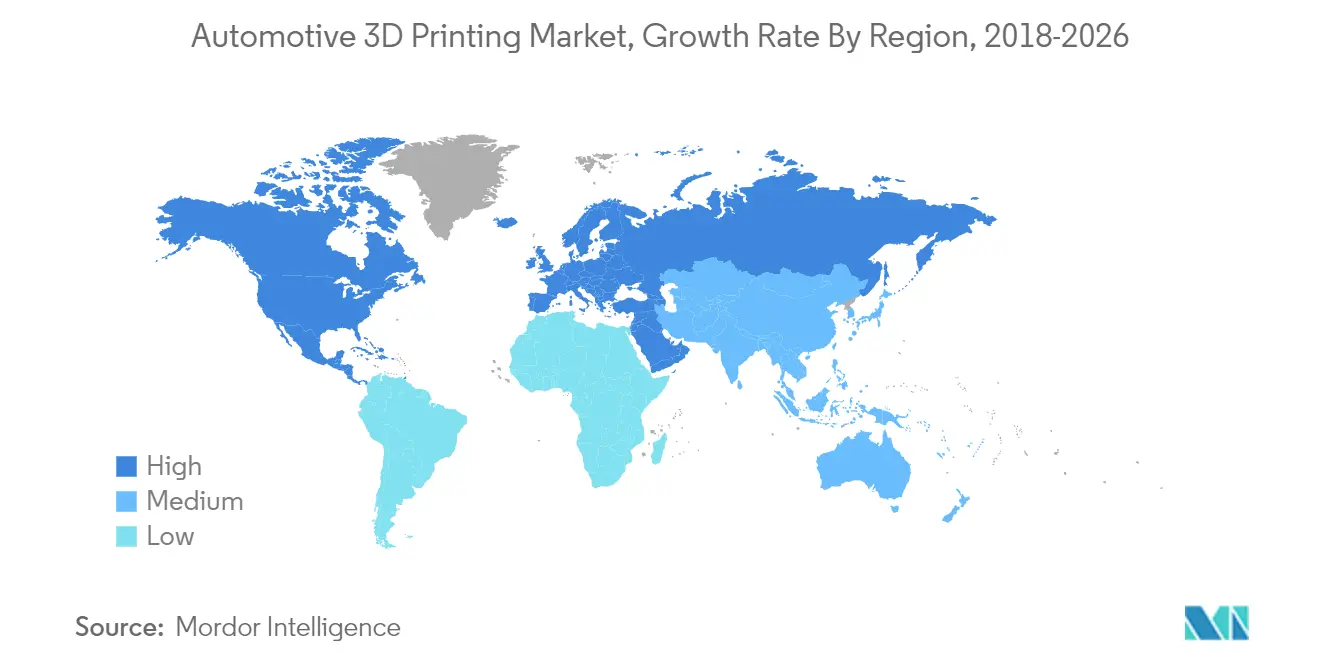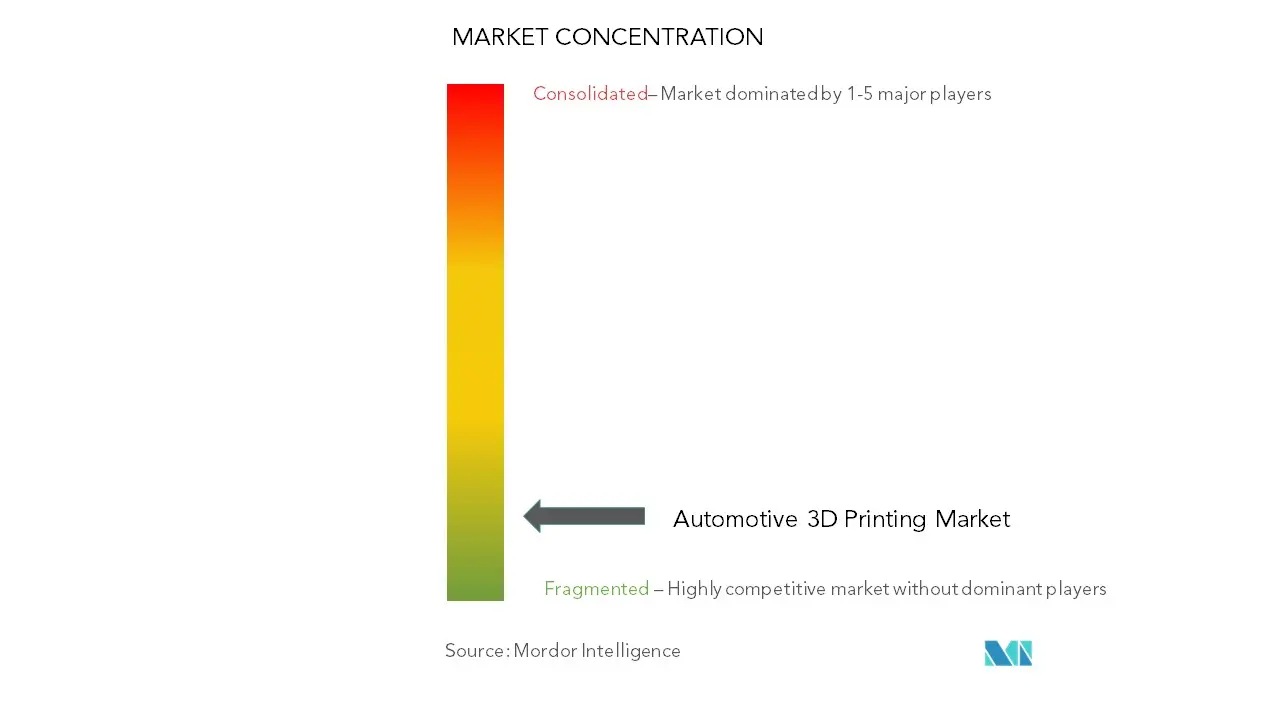Automotive 3D Printing Market Analysis
The Automotive 3D Printing Market is expected to register a CAGR of 21.74% during the forecast period.
The automotive industry experienced unprecedented challenges and uncertainty due to the COVID-19 pandemic. The outbreak had a swift, severe and global impact on the globally integrated supply chains of the automotive industry due to the COVID-19-led lockdowns. Furthermore, the fall in automotive production and lack of labor significantly impacted the market during the first half of 2020. For instance, in 2020, global automotive production dropped to 77.62 million units, a drop of 16% over 2019. The manufacturers are investing in developing new 3D printing systems and expanding their manufacturing capacities. For instance,
- In September 2020, Materialise N.V. invested in Ditto, a 3D printing startup, to advance additive manufacturing technologies for various industries.
Over the long term, the automotive sector trend shortens the turnaround time, reduces material waste, lower manufacturing costs, enhances production rate, shorter overall times for quick automotive parts prototyping, new printing materials for 3D printing, and increased government spending in 3D printing research and development projects will produce considerable growth in the automotive 3D printing market during the forecast period.
Key players are engaging in partnerships to expand their market positions and win key contracts from automotive OEMs. For instance,
- In June 2022, Stratasys was named the official 3D printing partner for Toyota Racing Development. Stratasys' Fortus 450mc, F370, and new composite F370CR 3D printers will be used for production vehicles in the upcoming Toyota GR Cup Series.
Geographically North America was the largest market for automotive 3D printing services and technologies due to the significant presence of automotive 3D printer manufacturers, widespread adoption of 3D printing in the manufacturing industry, and various measures adopted by automotive manufacturers to embrace Industry 4.0 applications.
Thus the factors above are expected to drive significant growth in the automotive 3D printing market.
Automotive 3D Printing Market Trends
Growing Adoption of Fused Deposition Modeling Technology
The automobile industry is compelled to explore cost-effective techniques because of rising raw material prices and global economic instability. Advancements in techniques and materials employed in additive manufacturing are expected to create new frontiers for 3D printing in the automotive sector. Optimization and implementation of additive manufacturing techniques such as 3D printing are unavoidable for automakers to achieve successful output. Using this technology for prototyping proved to be a highly cost-efficient and time-saving achievement.
In the automotive sector, FDM is one of the most often utilized 3D printing methods. Its ability to use various methods for producing prototypes, concept model parts and final products helped it maintain a significant portion of the automotive 3D printing market. The inputs for this computer-assisted method come from the model's processing unit. The technique often employs thermoplastic materials, resulting in ultra-light finished goods. In addition, advanced high-performance engineering-grade thermoplastics can be used in the process, resulting in resistant, strong, and remarkably light items.
The supporting benefits, such as minimum waste and a low carbon footprint, rage the industry to adopt it more widely. Technological improvements in FDM technology, which allow 3D printing of parts made of materials like carbon fiber and carbon fiber-reinforced polymers, have made the procedure even more critical to automakers. The ability of the FDM method to 3D print carbon fiber vehicle parts reduces manufacturing costs and time while minimizing conventional manufacturing processes' environmental impact.
Growing automobile production is also expected to significantly contribute to the growing adoption of 3D printing in the automotive industry. For instance, in 2021, global automotive production reached 80.14 million units, a growth of 3.13% over 2020.
Thus, the above factors are anticipated to expand the market for 3D printing in the automobile industry worldwide during the forecast period.
North America to dominate the automotive 3D printing market
Primarily owing to the technology's early adoption, North America now occupies the largest market share, followed by Europe and Asia-Pacific. North America and Europe dominate the industry due to the large number of OEM manufacturers who invest a considerable portion of their revenue in research & development. Many automobile manufacturers are investing in 3D printing to manufacture customized automotive parts to achieve shortened turnaround time, reduce material waste, lower manufacturing costs, enhance production rate, and shorter overall times for quick prototyping of automotive parts. For instance,
- In December 2021, BMW i Ventures, BMW Group's investment arm, provided seed capital to elastomer 3D printing start-up Rapid Liquid Print (RLP). Rapid Liquid Print (RLP) licensed its gel dispensing technology from MIT's Self Assembly Lab, which can produce soft, pliable products by using industry-standard materials like foams, rubbers, and silicones.
However, due to the falling price of 3D printers, the critical automotive manufacturing regions of Europe and Asia Pacific, which are still in the early stages of automotive 3D printing adoption, are likely to develop faster than in North America throughout the forecast period.
Due to many factors, such as many start-ups entrance into the market, a developed chemical industry, government efforts, skilled labor availability, and low-cost raw materials, Asia-Pacific is also predicted to exhibit a healthy rise in the Automotive 3D printing market over the forecast period.
Automotive 3D Printing Industry Overview
The automotive 3D printing market is highly fragmented due to the presence of many startups and some established players. Some major players operating in the global automotive 3D printing market include Voxeljet AG, Stratasys Ltd, the Exone Company, Materialise NV, Arcam AB, 3D Systems Corporation, and Eos GmbH, among others. These players are investing heavily in technology developments to bring out the latest methods and materials that will allow automotive companies with products of enhanced material properties in less time and engage in partnerships and mergers acquisitions to cement their market positions.
- In November 2022, Materialise N.V. announced that seven additional partners had joined its CO-AM platform. These solutions support design and pre-printing automation, traceability, printing, and post-processing for 3D-printed parts.
- In October 2022, Stratasys Ltd. acquired the quality assurance software firm Riven. Riven is a connectivity partner of Stratasys Ltd., and this acquisition enabled Riven's cloud-based solution to be integrated fully with Stratasys' GrabCAD 3D printer.
- In October 2021, Brose and Voxeljet AG announced the participation of Brose in Voxeljet's High-Speed Sintering (HSS) Early-Access Beta Program when Brose invested in its first VX1000 HSS.
Automotive 3D Printing Market Leaders
-
Voxeljet AG
-
Stratasys Ltd
-
ExOne
-
3D Systems
-
Materialise NV
- *Disclaimer: Major Players sorted in no particular order
Automotive 3D Printing Market News
- November 2022- Desktop Metal, the parent company of ExOne, announced that it had won a USD 9 million order from one of the major German car manufacturers for binder jet additive manufacturing systems used for the mass production of powertrain components.
- November 2022- 3D Systems and ALM announced a partnership to expand access to industry-leading 3D printing materials. ALM will add DuraForm PAx material manufactured by 3D Systems to its portfolio, enabling its customers to access a unique copolymer designed explicitly for use with available Selective Laser Sintering (SLS) technologies.
- September 2022- Stratasys Ltd. announced to completion of the merger of its subsidiary MakerBot with NPM Capital-backed Ultimaker to form a new company called Ultimaker. NPM Capital will own a 53.5 % stake in the new company, while Stratasys Ltd will hold the remaining 46.5%. The new company is operating from 31st August 2022.
- September 2022- Materialise N.V. announced the acquisition of Identify3D, a company that develops software to encrypt, distribute, and trace the flow of digital parts across complex supply chains. This acquisition will make Materialise's Co-AM additive manufacturing platform the most secure additive manufacturing platform.
- August 2022- Stratasys Ltd. signed an agreement to acquire Covestro AG's additive materials manufacturing business. This acquisition is anticipated to enable Stratasys Ltd to broaden its portfolio and accelerate the development of next-generation additive materials.
- August 2022- Voxeljet AG signed a sale-leaseback agreement for its 135,380 sq ft facility in Friedberg, Germany. This sale-leaseback agreement is expected to generate EUR 26.5 (USD 26.78) million in gross proceeds.
Automotive 3D Printing Industry Segmentation
3D printing is alternatively known as additive manufacturing, which is the process of creating a three-dimensional object layer by layer with the help of computer-aided design (CAD). In the automotive industry, 3D printing makes customized automotive parts to shorten the turnaround time, reduce material waste, lower manufacturing costs, enhance production rate, and shorter overall times for quick prototyping of automotive parts.
The Automotive 3D Printing Market is segmented by technology type, component type, material type, application type, and geography. Based on technology type, the market is segmented as Selective Laser Sintering (SLS), Stereo Lithography (SLA), Digital Light Processing (DLP), Electronic Beam Melting (EBM), Selective Laser Melting (SLM), and Fused Deposition Modeling (FDM). By component type, the market is segmented as hardware, software, and service. By material type, the market is segregated into metal, polymer, and ceramic. By Application Type, the market is segmented as production and prototyping/R&D. By geography, the market is observed as North America, Europe, Asia-Pacific, and the rest of the world.
The report offers market size and forecasts for Automotive 3D Printing Market in value (USD billion) for all the above segments.
| By Technology Type | Selective Laser Sintering (SLS) | ||
| Stereo Lithography (SLA) | |||
| Digital Light Processing (DLP) | |||
| Electronic Beam Melting (EBM) | |||
| Selective Laser Melting (SLM) | |||
| Fused Deposition Modeling (FDM) | |||
| By Component Type | Hardware | ||
| Software | |||
| Service | |||
| By Material Type | Metal | ||
| Polymer | |||
| Ceramic | |||
| By Application Type | Production | ||
| Prototyping/R&D | |||
| Geography | North America | United States | |
| Canada | |||
| Rest of North America | |||
| Europe | Germany | ||
| United Kingdom | |||
| France | |||
| Rest of Europe | |||
| Asia-Pacific | China | ||
| Japan | |||
| India | |||
| Rest of Asia-Pacific | |||
| Rest of the World | Brazil | ||
| Argentina | |||
| Other Countries | |||
Automotive 3D Printing Market Research FAQs
What is the current Automotive 3D Printing Market size?
The Automotive 3D Printing Market is projected to register a CAGR of 21.74% during the forecast period (2025-2030)
Who are the key players in Automotive 3D Printing Market?
Voxeljet AG, Stratasys Ltd, ExOne, 3D Systems and Materialise NV are the major companies operating in the Automotive 3D Printing Market.
Which is the fastest growing region in Automotive 3D Printing Market?
Europe is estimated to grow at the highest CAGR over the forecast period (2025-2030).
Which region has the biggest share in Automotive 3D Printing Market?
In 2025, the North America accounts for the largest market share in Automotive 3D Printing Market.
What years does this Automotive 3D Printing Market cover?
The report covers the Automotive 3D Printing Market historical market size for years: 2020, 2021, 2022, 2023 and 2024. The report also forecasts the Automotive 3D Printing Market size for years: 2025, 2026, 2027, 2028, 2029 and 2030.
Our Best Selling Reports
3D Printing in Automotive Industry Report
Statistics for the 2025 Automotive 3D Printing market share, size and revenue growth rate, created by Mordor Intelligence™ Industry Reports. Automotive 3D Printing analysis includes a market forecast outlook for 2025 to 2030 and historical overview. Get a sample of this industry analysis as a free report PDF download.

